Today, price and strength may not be a decisive selection criteria and super-strong adhesives are not a gamechanger for concrete bonding.
Adhesives are increasingly being used in the construction and building industries. On the one hand, this concerns dowel reinforcements that use chemical anchors. On the other hand, the sealing and repair of cracks in concrete structural components, such as bridges, columns, or facades, are still on the rise. In adhesive bonding, the interface between the joined materials is the most critical area. Therefore, it is of immense importance to characterize and investigate this section sufficiently. Literature reviews regarding concrete bonding reveal that only a few publications using adhesive systems are found. Most publications deal with pure concrete-to-concrete bonding, where new concrete layers are applied on top of old ones. However, since these are not traditional polymeric adhesive bonds, those concrete-to-concrete bonding situations are not focused on in this article.
Another major field of research concerns the bonding of fiber-composite components for external reinforcement of concrete buildings. This often takes the form of mats joined by epoxy resin bonding. Traditional mechanical test methods, such as the pull-off test or the shear test, are used to characterize the adhesion properties of the bonded bulk. Also, fracture analysis already plays a major role, where substantial information about a joint’s delamination behavior by means of cracking can be obtained. Unfortunately, to the best of the author’s knowledge, no comprehensive evaluation concept of adhesives for concrete bonding can be found in the literature.
Thus, this article highlights the above gaps and alternatively provides decision-makers with helpful information for objective adhesive evaluation and selection. For this purpose, a specially developed structural adhesive safety factor and an adhesive safety premium were developed to close the economic knowledge gaps on technical product sheets provided by manufacturers. Furthermore, a mathematical concept was applied to create an adhesive bonding performance index that allows for independent empirical peer ratings of the adhesives under investigation. Finally, the study completed experimental tests on ten different polymeric adhesive systems on concrete bonds. The results show that only a fraction of the adhesive systems tested are suitable for the structural bonding of concrete components. This enables the creation of objective evaluation parameters on a techno-economic basis that can lead to a significant knowledge gain compared to information provided by manufacturers’ technical datasheets.
Materials and Methods
The Table shows a compilation of evaluated polymeric adhesive systems from this study used to bond concrete joints. In total, ten adhesives of seven chemical systems were selected. All information was taken from the manufacturer’s datasheets. The producers classified the candidates as suitable for joining concrete components or at least not declared unsuitable.

Evaluation Methods
Adhesion Bonding Quality
The first evaluation methodology relates to the adhesion bonding quality (ABQ) of the interface. It is measured employing fracture analysis and describes the ex-post wetting of the adhesive surface after complete separation of the test specimens. The adhesion bonding quality can be determined via fractography based on the percentage distribution of the adhesive wetting in [%] of the fractured surface. Standards and technical guides generally distinguish between cohesive failure, adhesive failure, and mixed failure. The author has made his classifications and marked these with type A [cohesive failure], type B [mixed failure], and type C [adhesive failure], and coined the term adhesion bonding quality.
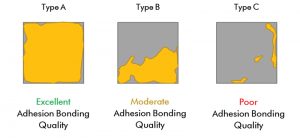
Figure 1 shows the above divisions by way of illustration:
- excellent adhesion bonding quality due to pure cohesive failure (type A),
- moderate adhesion bonding quality due to mixed failure (type B),
- poor adhesion bonding quality due to pure adhesion failure (type C).
Structural Safety Factor
There are well-established and proven approaches widely used in fracture analysis, such as the non-linear plastic fracture mechanics approach called the “GF principle.” from Hillerborg (1985). For the interested reader, further applications of his method are reported for concrete, wood, adhesives, and bio-composites. Unfortunately, since the GF value is a single fracture analysis criterion, other material-specific factors, such as strength and toughness, are not fully considered. Therefore, a multi-parameter approach was created, and a single evaluation index was formed using three fracture characteristic values. Such an approach benefits from an effective and holistic characterization of empirical material properties into one metric: a simpler interpretation of their meaning and a more straightforward presentation of a complex issue for decision-makers. The alternative is offered by forming a so-called structural safety factor, SF, a multi-parameter hybrid figure incorporating several fundamental fracture analytical material properties based on fracture analysis. Equation 1 describes the relationship:
SF = f (GF ∙ σc ∙ lch) (Eqn.1)
with GF as the specific fracture energy in foot-pounds per square inch [foot-pounds/square inch], σc the interfacial cohesive strength in pound-force per square inch [psi], and lch as the characteristic length in inches [inch]. Figure 2 depicts these single metrics used to create the safety factor. They represent the size, shape, and course of the stable load-displacement diagram of the adhesive under investigation.
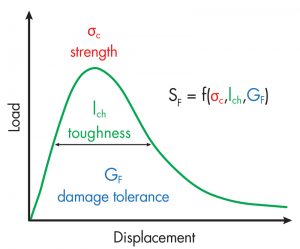
Peer Bonding Performance
Finally, as evaluation metrics have been created, a mathematical value analysis in the form of a peer group evaluation was conducted. This was accomplished by creating an adhesive bonding performance (ABP) parameter, which measures the adhesive’s relative peer performance, including both safety costs and bonding safety. This ABP enables an empirically valid performance rating. Figure 3 illustrates the basic concept of this mathematical approach.
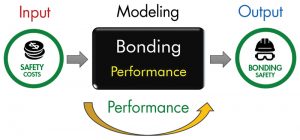
Results and Discussion
The results of this study are presented based on ten different adhesives for concrete bonding. Figure 4 shows the peer safety portfolio of the tested adhesive systems for concrete bonding. It considers the adhesive bonding efficiency formed by the adhesion bonding quality described above and the safety factor. The different colors represent the structural safety according to the traffic light system highlighting the risk of unstable failure.
It is noticeable that three clusters have been formed. The first one focuses on a two-component structural adhesive of types epoxy (EPV), cyanoacrylate/acrylate hybrid (HYS), and polyurethane (PUV), with basically high strength and low elasticity, especially for metal bonding. However, they exhibit very low adhesion properties at concrete interfaces, which leads to a massive deterioration of the structural bonding safety. This fact is expressed by low safety factors ranging from 6.4% for the epoxy-based EPV adhesive up to 16.1% for the SAC-based candidate named KSB. Consequently, those candidates are marked with small red balloons indicating low bonding safety (high failure risk). Styrene-acrylic and pure acrylic-based adhesives (KSB, URF, MAC) form the second cluster, likewise revealing very low structural safety and bonding performance values. Consequently, they were also marked with small red balloons demonstrating a high risk of unstable failure.
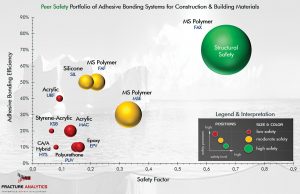
The final cluster is formed by silicone (SIL) and silane-modified polymer adhesives (MSE, FAF, FAX). They are marked in yellow and demonstrate adhesive safety factors ranging from 18.3% to 32.9%. Interestingly, the silane-modified polymer-based adhesive FAX highlights by far the highest bonding performance with a measured bonding efficiency of 70% at a safety factor level of 66.8%. This could be explained by the high energy storage capacity of the adhesive during the fracture process. In a final step, the bonding performance of the entire group was calculated, comprising bonding safety, bonding quality, and adhesive safety premium. Figure 5 summarizes the total results in a rating and ranking compilation. Again, the colored distinctions emphasize the risk of unstable failure.
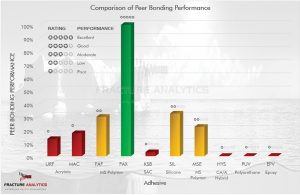
Conclusion
In this study, different polymeric adhesive bonding systems – some of which are commercially used by practitioners and operators in the construction industry – were evaluated for their safety, performance, and efficiency at concrete bonds. This became necessary as technical data sheets and manufacturer’s specifications often lack valid data and decision support. Furthermore, the literature has shown that standardized test methods are technologically incapable of providing such information. Therefore, fracture analysis was used as an evaluation tool to create empirical analysis data. Multifactorial assessment parameters could be generated by combining the GF test method and an innovative evaluation method from Brandtner-Hafner (2017, 2019, 2020, 2021). These were then used to create mathematical evaluation models for generating adhesive bonding performance incorporating structural safety and structural premium. Ten different adhesive candidates used for bonding concrete joints adhesively were tested experimentally. This holistic analysis demonstrated that only adhesive systems with high energy storage capacity during the fracture process could fail safely. Specifically, this means that epoxy-, polyurethane-, and cyanoacrylate-based adhesives do not improve the structural integrity of bonded concrete joints, such as anchors or crack repair fillers, as is the standard used for refurbishment in the construction and building industry. Therefore, more suitable alternatives are necessary to overcome such shortcomings. Further future research will show how this new finding can and will affect the joining technology of concrete.■
References
M. E. Mohamad and I. S. Ibrahim, “Interface shear strength of concrete-to-concrete bond with and without projecting steel reinforcement:” Jurnal Teknologi, vol. 75, no. 1, pp. 169-172, 2015.
P. Santos and E. Júlio, “Assessing concrete-to-concrete bond strength by measuring the roughness of the substrate surface,” in IABSE Symposium: Responding to Tomorrow’s Challenges in Structural Engineering, Budapest, Hungary, September 12-15, pp. 17-24, 2006.
B. Kabiri Far and C. Zanotti, “Concrete-to-concrete bond in mode-I: A study on the synergistic effect of surface roughness and fiber reinforcement,” Appl Sci, vol. 9, no. 12, 2556, 2019.
A. O. Hilal, A. Z. Hamoody and A. S. Saadoon, “Behavior of FRP sheet-concrete bond in high strength concrete samples,” in IOP Conference Series: Materials Science and Engineering, vol. 1090, no. 1, p. 012105, 2021.
M. W. C. Himasha, J. C. P. H. Gamage, G. I. P. De Silva, V. Attanayaka, “Modification of engineered cementitious composite mortar to use as an adhesive for CFRP/Concrete bond, ICSBE, Singapore, pp. 461-476, 2020.
E. N. B. S. Júlio, F. A. B. Branco and V. D. Silva, “Concrete-to-concrete bond strength: influence of an epoxy based bonding agent on a roughened substrate surface,” Magazine of concrete research, vol. 57. No. 8, pp. 463 468, 2005.
D. J. Cleland and A. E. Long, “The pull-off test for concrete patch repairs,” Proceedings of the Institution of Civil Engineers, Structures & Buildings, vol. 122, no. 4, pp. 451–460, 1997.
E. Bonaldo, J. O. Barros, P. B. Lourenço, “Bond characterization between concrete–Base and repairing SFRC by pull-off tests”, Report 04-DEC/E-13, Universidade do Minho, Departamento de Engenharia Civil, Guimarães, Portugal, May, 2004.
X.-K. Zhu and J. A. Joyce, “Review of fracture toughness (G, K, J, CTOD, CTOA) testing and standardization,” Engineering Fracture Mechanics, vol. 85, no. 5, pp. 1–46, 2012.
A. Hillerborg, “The theoretical basis of a method to determine the fracture energy GF of concrete,” Materials and Structures, vol. 18, no. 4, pp.291–296, 1985.
H. Cifuentes, M. Alcalde, F. Medina, “Measuring the size-independent fracture energy of concrete,” Strain, vol. 49, no. 1, pp. 54–59, 2013.
B. L. Karihaloo, H. M. Abdalla, and T. Imjai, “A simple method for determining the true specific fracture energy of concrete,” Magazine of Concrete Research, vol. 55, no. 5, pp. 471–481, 2003.
K. Forsman, E. Serrano, H. Danielsson, and J. Engqvist, “Fracture characteristics of acetylated young Scots pine,” European Journal of Wood and Wood Products, vol. 78, no. 4, pp. 693–703, 2020.
M. H. Brandtner-Hafner, “Interface fracture behaviour of industrial adhesives: A novel evaluation approach for adhesive selection,” in Proceedings of the IN-ADHESIVES Symposium on Innovations in Adhesives and their Applications, Munich, February 14-15, pp. 221-229, 2017.
M. H. Brandtner-Hafner, “Assessing the natural-healing behavior of adhesively bonded structures under dynamic loading,” Engineering Structures, vol. 196, no. 10, 109303, 2019.
M. H. Brandtner-Hafner, “Structural safety evaluation of adhesive bonds: A fracture analytical approach,” Engineering Failure Analysis, vol. 123, no. 5, 105289, 2021.
M. H. Brandtner-Hafner and D. Diáz Batista, “Techno-economic evaluation of biocomposites: A fracture analytical approach,” Engineering Fracture Mechanics, vol. 240, no. 12, 107346, 2020.
DIN EN 10365, “Adhesives – Designation of main failure patterns,” Beuth, Berlin, Germany, 2020.
DVS 3302, “Bonding in car body construction: evaluation of failure patterns,” Beuth, Berlin, Germany, 2018.
